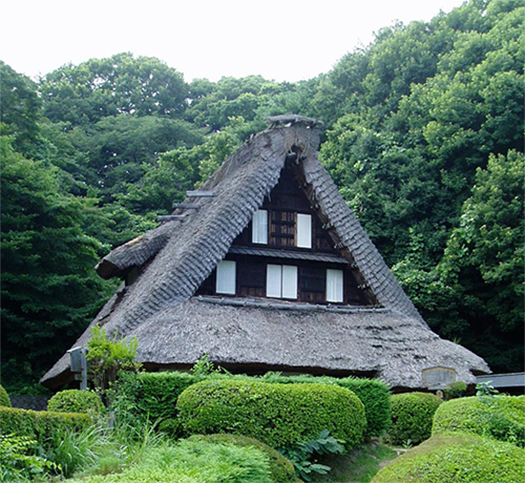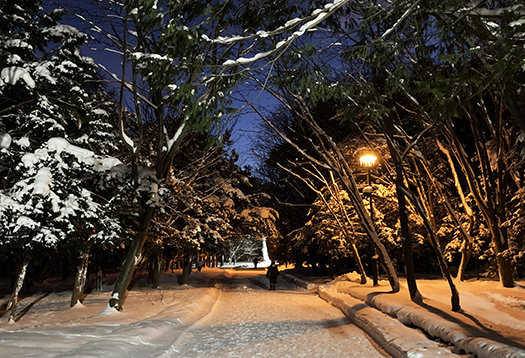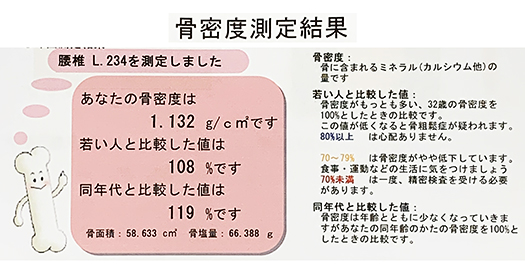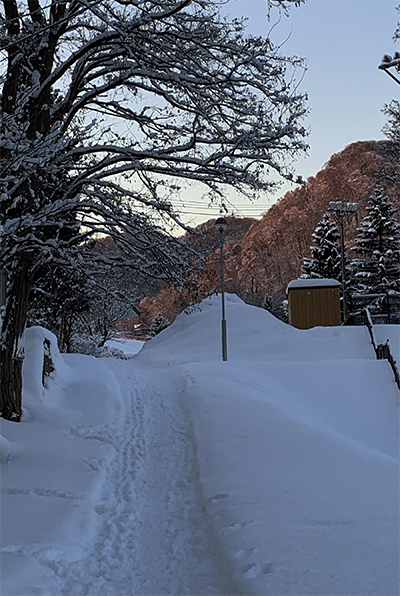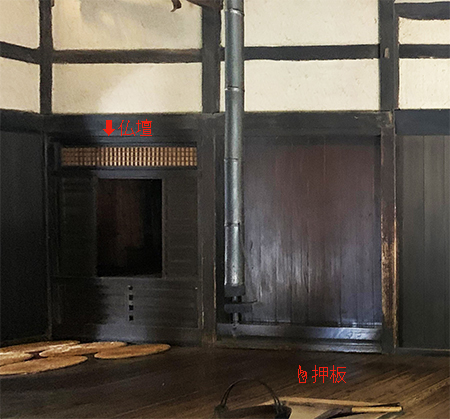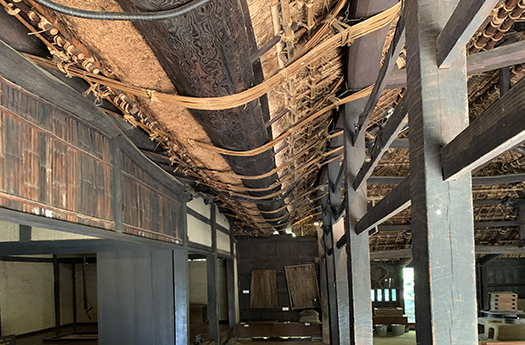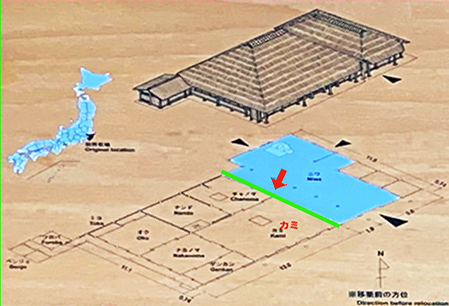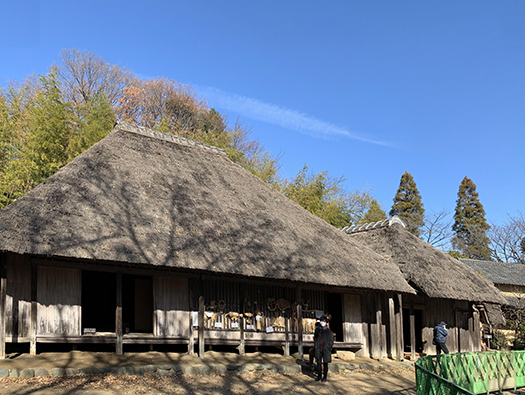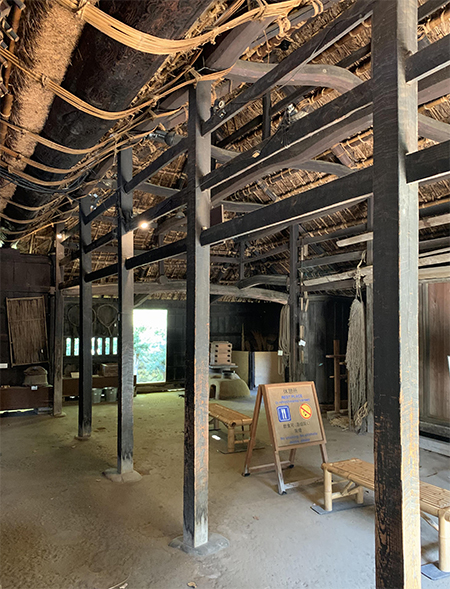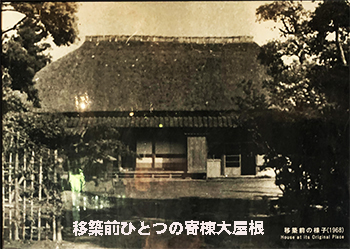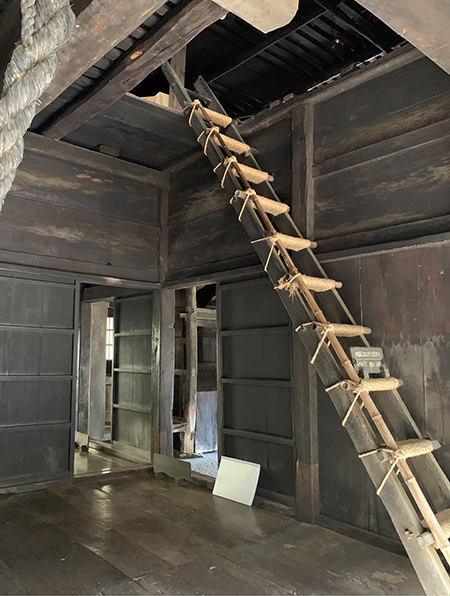
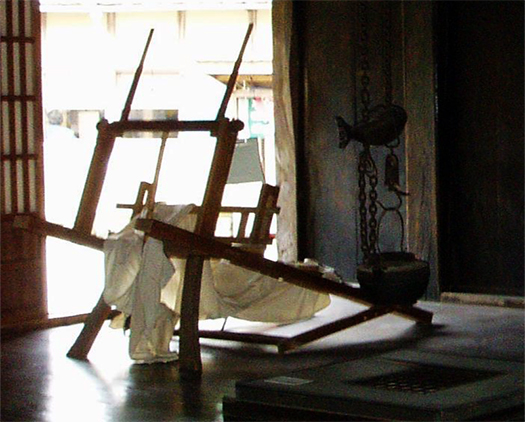
古民家を集中して取材対象にして記事まとめをしていますが、
進めるほどに古民家の多様性、その「生業」の色濃さに驚く。
古民家というと、木質が囲炉裏火で長期燻煙の意匠性に目が行くけれど、
わたしの立場のように現代住宅との対比で見ると、
むしろそこでの人々の「生き様」、生業の痕跡に深く気付かされる。
たしかに生命維持装置としての台所や食遊空間としての囲炉裏、
寝室、先祖崇拝の神聖空間、迎賓室など大きく変わらない機能装置は
現代住宅も引き継いでいるけれどそれは当たり前の人間活動保証部分。
一方で古民家を個性的に彩っているのは生業装置の部分。
土間が民の生きる糧を支える空間として機能し、
その住宅建築の「いのち」を保証していた様子が明瞭に伝わってくるのです。
現代住宅から大きく失われつつある、生業の要素が大きく浮かんでくる。
現代は職住がほぼ完全に分離してしまっているし、居住地域も
「専用住宅地」としての地域に偏在するようになっているけれど
古民家では「その地での生き方」に最適化された立地選択になっている。
いや、その土地で生き続けることに必死だった事実が跡づけられているのだ。

雪深い山村での暮らしは、広い農地面積を確保はできない。
戦前の軍事態勢のころまで、この越中五箇山からはコメの出荷はなかったとされる。
コメ生産は自分たちの食料分だけの農地しかなく、
男たちは冬場になれば仕事がなくなって、都会に出稼ぎに出るのが必然。
そういった地域にあって養蚕は最重要な経済活動であっただろう。
合掌造りによる高く大きな屋根景観はたしかに豪雪を落雪させる機能も持ったが、
それ以上にその小屋裏空間に養蚕の場を確保するというのが、
最大の起因だっただろうことは明白。
この家でも、いちばん上の写真のように土間を上がってすぐの居室から
2階へのハシゴが掛けられて蚕の世話が垣間見えている。
2階床面はスノコ状で様子は下階から様子をみることができる。
そして板敷きの生活空間では、機織りが大きな存在を占めている。
女性たちの機織りは、多くの日本民話にも登場するけれど、
日本で普遍的に行われてきた女性としての「生業」。
また養蚕の「蚕の世話」もいかにも母性を感じさせる生産営為。
日夜、養蚕業に勤しむ彼女たちの暮らしぶりが生き生きと甦る。
また、この家の日常生活空間からは土間での「紙すき」作業も
見晴らしよくコントロール下に収められている。

こういった生業主体の住宅には、強い永続性を感じる。
一方で、東京の戦前期などの「高級住宅」もたくさん見てきたけれど、
生命維持装置空間と対比的な「生業」空間はほぼないと言える。
あれらはやはり「武家住宅」の生まれ変わりのように思えてならない。
江戸期の武士とは生産活動と無縁でたんなる「搾取者」。
人間と経済活動にはまったく無能で、自らの階級誇示だけが目的に思える。
たしかに日本文化の粋を凝らした迎賓的空間は展開するけれど、
そのこと自体は、居住者の人格を保証するものではないだろう。
先祖崇拝空間でもない、床の間座敷のようなステータス部分にのみ、
一所懸命にこだわっている様子が顕著なのだと思う。
そして現代住宅は基本的に、そのような都市住宅の系譜に属している。
コロナ禍は家の存在価値をも再度ふるいに掛けようとしている。
いまや、生業はパソコンと通信で可能になっていくのが社会の方向性。
さてわたしたちの「住宅文化」はどういった方向に向かうのだろうか?
English version⬇
[Sericulture and weaving, women’s livelihood / Japanese good house ⑳-3]
I’m concentrating on old folk houses and summarizing the articles.
The more you proceed, the more you will be surprised at the diversity of old folk houses and the color of their “living business”.
Speaking of old folk houses, the wood is the hearth fire, and the design of long-term smoke is noticeable.
If you look at it in comparison with modern houses like my position,
Rather, people are deeply aware of the “lifestyle” and traces of their livelihoods.
Certainly the kitchen as a life support system and the hearth as a dining space,
Functional devices that do not change significantly, such as bedrooms, sacred spaces for ancestor worship, and guest rooms
The modern housing has been taken over, but that is the part that guarantees human activity.
On the other hand, it is the part of the livelihood equipment that uniquely colors the old folk house.
The dirt floor functions as a space that supports the livelihood of the people,
You can clearly see how the “life” of the residential building was guaranteed.
The element of livelihood, which is being greatly lost from modern housing, comes to the fore.
In modern times, work and residence are almost completely separated, and the area of residence is also
Although it is unevenly distributed in the area as a “private residential area”
In the old folk house, the location selection is optimized for “the way of life in the area”.
No, the fact that he was desperate to stay alive in the land is traced.
Living in a snowy mountain village cannot secure a large agricultural land area.
It is said that rice was not shipped from Gokayama in Etchu until the time of the military situation before the war.
Rice production is limited to farmland for their own food,
It is inevitable that men will run out of work in winter and go to work in the city.
Sericulture would have been the most important economic activity in such areas.
The tall and large roof landscape created by the gassho-zukuri has a function to make heavy snowfall, but
More than that, securing a place for sericulture in the space behind the hut is
It is clear that it was probably the biggest cause.
Even in this house, as shown in the photo at the top, from the living room right after going up the dirt floor
A ladder is hung on the second floor to give a glimpse of the care of the silk moths.
The floor on the second floor is slatted and you can see the situation from the lower floor.
And weaving occupies a large part in the living space with planks.
Women’s weaving appears in many Japanese folk tales,
“Livelihood” as a woman that has been universally practiced in Japan.
In addition, “care for silk moths” for sericulture is also a production activity that makes you feel motherhood.
Day and night, the lifestyles of the women who work in the sericulture industry are revived.
Also, from the daily living space of this house, you can also do “papermaking” work in the soil.
It has a good view and is kept under control.
I feel a strong sense of permanence in these livelihood-based housing.
On the other hand, I’ve seen a lot of “luxury homes” in Tokyo before the war,
It can be said that there is almost no “living” space that contrasts with the life support system space.
They must not seem like a rebirth of a “samurai residence”.
An “exploiter” who has nothing to do with production activities with the samurai of the Edo period.
He is totally incompetent to humans and economic activity, and seems to have only the purpose of showing off his class.
It is true that a guest space with elaborate Japanese culture develops, but
That in itself would not guarantee the personality of the resident.
Only in the status part like the alcove, which is not an ancestor worship space
I think it’s remarkable that they are sticking to it very hard.
And modern housing basically belongs to the genealogy of such urban housing.
Corona is trying to sift the value of the house again.
Nowadays, the direction of society is that livelihoods can be made possible by communicating with personal computers.
What direction is our “housing culture” going in?
Posted on 1月 31st, 2021 by 三木 奎吾
Filed under: 住宅マーケティング, 日本社会・文化研究 | No Comments »





